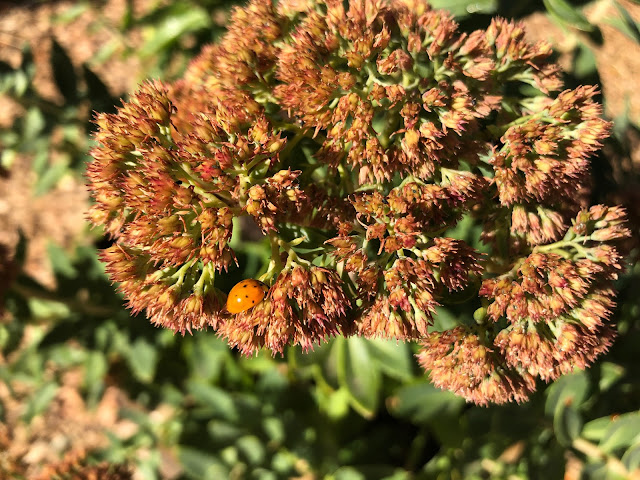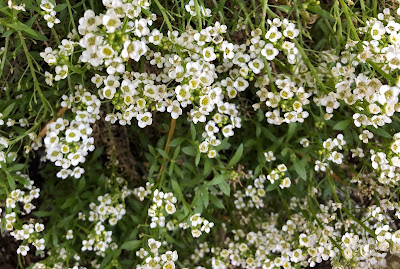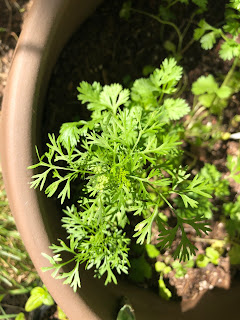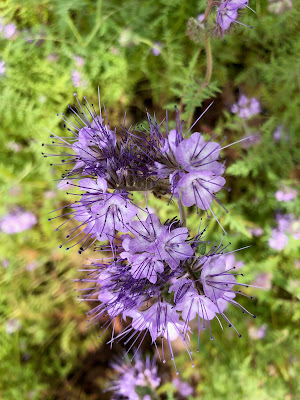
|
|
Give 'em what they like! A lady beetle hangs out on a stonecrop plant at the Fair Oaks Horticulture Center last fall. (Photos:
Kathy Morrison)
|
Growing plants they favor will encourage them to stick around
Want some free pest-fighting help in the vegetable garden this summer? Nearby or among the vegetables, grow plants to encourage and feed beneficials -- the "good bugs" that fight the bad ones.
The most well-known beneficial is the lady beetle (ladybug), who famously dines on aphids, but she has plenty of other buddies in the garden that are predators or parasites of nasty, plant-destroying pests. Other "good bugs" include green lacewings, hoverflies, tachinid flies, braconid and other parasitic mini wasps, minute pirate bugs, damsel bugs and big eyed bugs.
A lot of these good guys are teeny, and don't have the lady beetle's showy coloring, so you may not notice them. But they are hard-working and important in the garden. And they need food and water, too.
Incidentally, this is a different kind of list than you usually see for pollinators, although some of these plants appeal to bees and butterflies, too. When choosing plants for beneficials, ones with small flowers are preferable to those with large single flowers. Small insects may actually drown in a big bloom's abundant nectar.
Two important notes:
1) Do not use broad-spectrum insecticides in the garden if you expect these bugs to help you out. Who hires a work crew and then poisons them?

|
|
Sweet alyssum is easy to find and grow for beneficials.
|
2) Choose species that aren’t difficult to control as weeds when the seeds spread into garden. And avoid plants that support insects, nematodes or pathogens that can be problems for your crop plants. As an example, alfalfa, which is recommended as a plant for beneficials, should not be grown near tomatoes. And tansy, another popular plant for beneficials, is poisonous to humans.
So here are some suggestions for each part of the vegetable-growing season:
Early (mid spring to early summer):

|
|
The cilantro's starting to bolt -- so let it.
|
Sweet alyssum --
Lobularia maritima.
This easy-to-find bedding plant attracts parasitic mini-wasps and hoverflies.
"Basket of Gold" alyssum --
Aurinium saxatiles
. Lady beetles like this low-water perennial, which naturalizes.
Thyme --
Thymus vulgaris
. This is one of many herbs you'll see on this list. Good for sunny, dry soils. It's important to let some of it bloom -- that's what the beneficials are after.
Borage --
Borago officinalis.
This tough little herb has blue flowers and blooms all season.
Cilantro --
Coriandrum sativum.
This herb drives Sacramento-area gardeners nuts, because it bolts (flowers) as soon as the weather warms. Well, here's a reason to let it bloom. Lacewings, hoverflies and lady beetles all like this.
Lacy phacelia --
Phacelia tanicetifolia.
This California native, with blue-purple flowers and lacy foliage, is one of my favorites. Tachinid flies and hoverflies are attracted to it, as are butterflies and bees.
Midseason (late spring to mid summer):
Basil --
Ocimum basilicum
. You're probably already growing this herb for pesto or margarita pizza. Dedicate some of the plants to the insects by letting them flower. Some of the purple basil varieties are especially good for this. And if you can find African blue basil, grab it: It's great insect magnet.
Caraway --
Carum carvi
. Another herb, this has a large insect fan base: Hoverflies, lacewing, parasitic mini-wasps, minute pirate bugs, damsel bugs and big eyed bugs.

|
|
Lacy phacelia is a gorgeous addition to the
spring garden.
|
Common yarrow --
Achillea millefolium
. California native and drought tolerant, it blooms into the late season. Attracts lady beetles. Also fern-leaf yarrow (
A. filipendulina
), which draws lacewings and lady beetles. There are many cultivars of yarrow.
Cosmos --
Cosmos bipinnatus
. This popular annual flower blooms June to frost. “White Sensation” attracts parasitic mini-wasps, hoverflies, lacewing, minute pirate bugs, damsel bugs and big eyed bugs.
Dill --
Anethum graveolens.
This herb often gets planted near tomatoes. It bolts in hot weather, so let it, and feed lacewings, parasitic mini-wasps and lady beetles.
Sedum --
Hylotelephium spectabile.
Stonecrop is good for dry spots, drought- and cold-tolerant, and blooms into fall. The small blooms attract hoverflies, lady beetles, butterflies and hummingbirds.
Late season (midsummer to early fall):
Buckwheat --
Fagopyrum esculentum,
It's drought-tolerant and good in any soil. Tachinid flies, lady beetles and hoverflies all like its flowers. Look also for
Eriogonum fasciculatum
'Warriner Lytle,' a buckwheat that's one of the 10 Rising Stars at the UC Davis Arboretum.
Coyote brush --
Baccharis pilularis
.
A California native, this tough little perennial blooms with white or yellow flowers in fall and winter.
Fennel --
Foeniculum vulgare
. A perennial herb and member of the carrot family, it's usually grown for the bulb and feathery leaves. The flowers attract a host of good guys: lady beetles, minute pirate bugs, damsel bugs and big eyed bugs.
Goldenrod --
Solidago virgaurea
. Gorgeous late-flowering plants, such as Peter Pan goldenrod, bring in hoverflies, minute pirate bugs, damsel bugs and big eyed bugs.
Prairie sunflower --
Helianthus maximilianii
. Late-season bloomers can be tougher to find. This tall perennial is a good one: It grows well in average soil, and attracts lacewings and lady beetles.
Statice, aka sea lavender --
Limonium latifolium.
Gardeners like to grow this for dried flowers, but beneficials such as hoverflies and parasitic mini wasps are drawn to it.
For more information on beneficials, see the UCCE publication
Garden Note 129
or
this post
at farmerfred.com.




